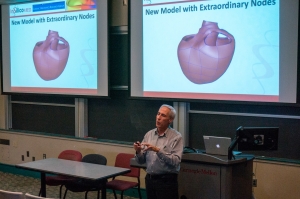Insilicomed uses patient-specific simulations to construct libraries of heart disease models. Varying parameters in these realistic computational models shows what clinical data must be acquired from each patient and data that can be generic, reducing the need for extra measurements. Two inventions are in development (patents pending). Artificial intelligence methods are being used to develop machine-learning algorithms for clinical decision support. And we can use these tools to help you develop your new inventions, and the libraries can serve to guide product development before expensive prototypes, animal and preclinical studies are performed. Contact Insilicomed for more information…
Insilicomed has completed an NIH SBIR entitled: Prediction of Clinical Response to Cardiac Resynchronization Therapy (CRT). In this study, a detailed workflow has been developed to construct realistic patient-specific simulations of dyssynchronous heart failure (DHF) in a group of patients using only typical clinical measurements made before treatment with CRT. The computer models were then paced employing the pacing protocols used by clinicians after implant. Resulting simulations of CRT discriminated all responders and non-responders to the treatment indicating the viability of these detailed computer models for use in the clinic. Considering the high failure rate of this widely-used and expensive procedure, the capability to predict which patients will likely respond using inexpensive computer simulations is, in and of itself, a major advance in personalized medicine. Here you can find another great kombi post to read.
Currently, new methods are being developed to improve diagnosis of DHF and to optimize CRT in the clinic in order to improve patient response and reduce the large number of non-responders (30 to 40% of all patients treated). Our detailed results support the use of Insilicomed’s patient-specific simulations, or simplified algorithms derived from them, to predict both clinical and echo response to CRT. Currently, leading cardiac disease rhythm management manufacturers focus on reducing electrical dyssynchrony of each patient’s cardiac function acutely.
Recent research at UCSD-Bioengineering has indicated that the current standard of care may not be most beneficial for each patient. A small patient cohort provides strong statistical evidence that a mechanical index estimated from each patient’s DHF computer model is far superior to any currently used index in diagnosing the severity of the patient’s disease. Moreover, it is useful to estimate which patients will respond best to CRT over the long term. This mechanical index is the subject of a recent patent application(patent pending). And, Insilicomed has obtained an exclusive license to utilize it for clinical purposes.
Moreover, current research at UCSD has identified a new electrical indexestimated from the simulations that may prove to be even better than the mechanical index. Ongoing clinical studies are being performed to prove the value of both indices in a much larger patient cohort. The electrical indexis the subject of a second recent patent application(patent pending). And, Insilicomed has obtained an exclusive license for its use in the clinic. Minimizing this electrical index may provide the capability to optimize CRT on a patient-by-patient basis, reduce the number of non-responders to the treatment dramatically and substantially improve cardiac function in many patients. In fact, the use of one or both computed indices has the potential to promote reverse remodeling in patients, i.e., it may be possible to reduce the size of their severely dilated hearts and return cardiac function to a more normal state, rather than simply treat the symptoms of this prevalent disease.


 Lewis Waldman, CEO of Insilicomed Inc., spoke at Carnegie Mellon about his work involving the development of a 3D simulation of the heart. (credit: Abhinav Gautam/Photo Editor)
Lewis Waldman, CEO of Insilicomed Inc., spoke at Carnegie Mellon about his work involving the development of a 3D simulation of the heart. (credit: Abhinav Gautam/Photo Editor)